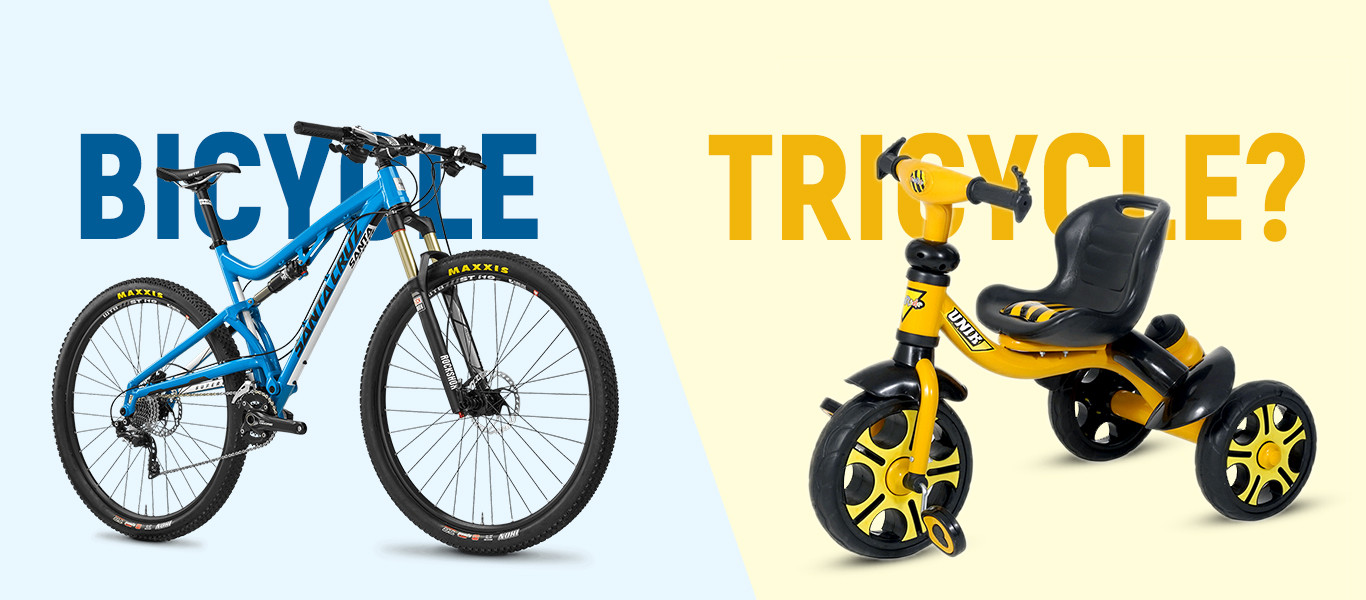What is the Difference Between a Bicycle and a Tricycle?
Apr 19, 2024

Bicycles and tricycles are iconic modes of transportation and recreation that have captivated the hearts of both children and adults for generations.
While bicycles are known for their sleek design and agility, tricycles offer a stable and secure riding experience with their three-wheel structure.
Whether it's a child's first taste of independence or an adult's leisurely ride through the park, bicycles and tricycles hold a special place in our hearts and continue to be popular choices for riders of all ages.
Difference Between a Bicycle and a Tricycle
Here are 5 main differences you’ll find in bicycle and tricycle –
Design and Structure:
Bicycles are characterized by their two-wheel design, with a frame that supports the front and rear wheels in line with each other. By pedaling, they move forward by rotating the bike's back wheel.
In contrast, tricycles feature a three-wheel design, with two wheels at the back and one wheel at the front, or two wheels at the front and one at the back. This additional wheel provides tricycles with increased stability compared to bicycles, making them ideal for riders who may struggle with balance.
Also read: What are the best tricycles for toddlers?
The triangular structure of tricycles distributes weight more evenly, reducing the risk of tipping over, especially at low speeds or when stationary.
Riding Experience:
Tricycles offer a more straightforward riding experience, particularly for those new to cycling. The third wheel's stability makes it simpler to maintain balance, which gives inexperienced riders a sense of control and confidence.
Unlike bicycles, tricycles don't require riders to balance themselves when stationary. This feature makes it easier to stop and start without the fear of toppling over, making tricycles a comfortable and accessible option for riders of all skill levels.
Safety Considerations:
Tricycles offer several safety benefits, particularly in reducing the risk of falls. The additional wheel provides greater stability, making it easier for riders to maintain their balance, especially when navigating corners or uneven terrain. This stability can be particularly advantageous for individuals with balance issues or physical limitations, as tricycles provide a secure and stable riding experience.
Overall, tricycles are often considered a safer option compared to bicycles, making them a popular choice for riders seeking a more secure and comfortable riding experience.
Age Considerations:
When it comes to riding bicycles and tricycles, age plays a crucial role in determining readiness and safety. For bicycles, children are typically ready to start learning around the age of 5 or 6 years, depending on their physical development and coordination.
On the other hand, tricycles are suitable for younger riders, with most children ready to ride around the age of 3 years. This age difference is due to the stability and balance requirements of each type of bike.
Also read: How to teach my baby to ride a tricycle?
Tricycles are particularly beneficial for young children who are learning to pedal for the first time. The three-wheel design provides added stability, allowing children to focus on developing their pedaling technique without the added challenge of balancing.
This early introduction to cycling can help children build confidence and coordination, setting a solid foundation for future cycling adventures.
Overall Use Cases:
Bicycles and tricycles serve a variety of purposes beyond mere transportation. They are popular choices for recreation, offering riders the opportunity to explore their surroundings and enjoy the outdoors.
Whether it's a leisurely ride through the park or a more adventurous journey along a scenic trail, bicycles and tricycles provide a fun and enjoyable way to stay active.
In addition to recreation, bicycles and tricycles are also commonly used for transportation. They offer an eco-friendly alternative to cars, allowing riders to commute to work or run errands while reducing their carbon footprint.
Bicycles, in particular, are often used in urban areas where traffic congestion and parking limitations make them a practical choice for getting around.
Furthermore, bicycles and tricycles are excellent tools for exercise. Cycling is a low-impact form of cardio that can help improve cardiovascular health, build muscle strength, and increase endurance.
Also read: Why is Toy Safety Important? Tips For Parents in 2024
Whether it's a casual ride around the neighborhood or a more intense cycling workout, bicycles and tricycles provide a versatile and effective way to stay fit and active.
Conclusion:
Bicycles and tricycles each offer unique advantages and cater to different needs and preferences.
Bicycles, with their two-wheel design, provide a more dynamic and agile riding experience, making them well-suited for those seeking speed and maneuverability.
Tricycles, on the other hand, offer increased stability and are easier to ride, making them ideal for beginners, children, and individuals with balance issues.
When choosing between a bicycle and a tricycle, it's important to consider your own needs and preferences. If you value speed and agility and are comfortable with balancing on two wheels, a bicycle may be the right choice for you. However, if stability and ease of use are more important, a tricycle may be a better fit.
Visit Dash Baby Ride today to explore our wide range of products for kids aged less than 12 years. From tricycles to swings, walkers to scooters, we have everything you need to keep your little ones active and entertained.

